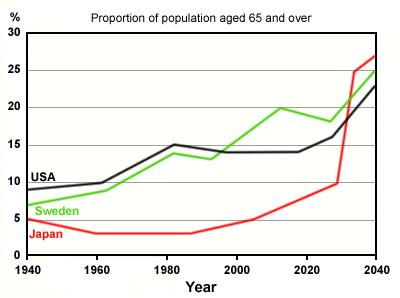The graph below shows the proportion of the population aged 65 and over between 1940 and 2040 in three different countries.
Given is the line graph presenting the overall growth in ageing population during a period of 100 years. The expected percentages are taken from three different countries between 1940 and 2040.
Overall, the percentages of ageing population from two Western countries has risen steadily in ten decades. In any case, this proportion declined slightly in Japan, but will be gradual rebound from 2000 onwards.
From the graph, we can see the number of elderly people in Japan stood at 5%. After declining to almost 3% in 1960, this trend remained reasonably steady, then was gradual rebound to the same figure in 1940. Between 2030 to 2040, the increase in this proportion will be more dramatically.
A closer look at the data reveals that the numbers of ageing population in the two Western countries have no significant difference. Standing at approximately 9 % in 1940, the percentage of older population in USA increased steadily to 10 % in the next ten years, then followed by the proportion of Swedish population aged 65 or more rose from 6 to 8 percent. Both figures, after a short peak in the forth decade, decreased gradually. The percentage of older population in USA had remained steady in 14%, while this figure in Sweden had broken a record, peaking at 20% in 2010 but falling again in the ninth decade. The proportion of ageing population in USA and Sweden will be predicted to rise dramatically until 2040.
Given is the line graph presenting the overall growth in ageing population during a period of 100 years. The expected percentages are taken from three different countries between 1940 and 2040.
Overall, the percentages of ageing population from two Western countries has risen steadily in ten decades. In any case, this proportion declined slightly in Japan, but will be gradual rebound from 2000 onwards.
From the graph, we can see the number of elderly people in Japan stood at 5%. After declining to almost 3% in 1960, this trend remained reasonably steady, then was gradual rebound to the same figure in 1940. Between 2030 to 2040, the increase in this proportion will be more dramatically.
A closer look at the data reveals that the numbers of ageing population in the two Western countries have no significant difference. Standing at approximately 9 % in 1940, the percentage of older population in USA increased steadily to 10 % in the next ten years, then followed by the proportion of Swedish population aged 65 or more rose from 6 to 8 percent. Both figures, after a short peak in the forth decade, decreased gradually. The percentage of older population in USA had remained steady in 14%, while this figure in Sweden had broken a record, peaking at 20% in 2010 but falling again in the ninth decade. The proportion of ageing population in USA and Sweden will be predicted to rise dramatically until 2040.

proportion_of_popula.gif
